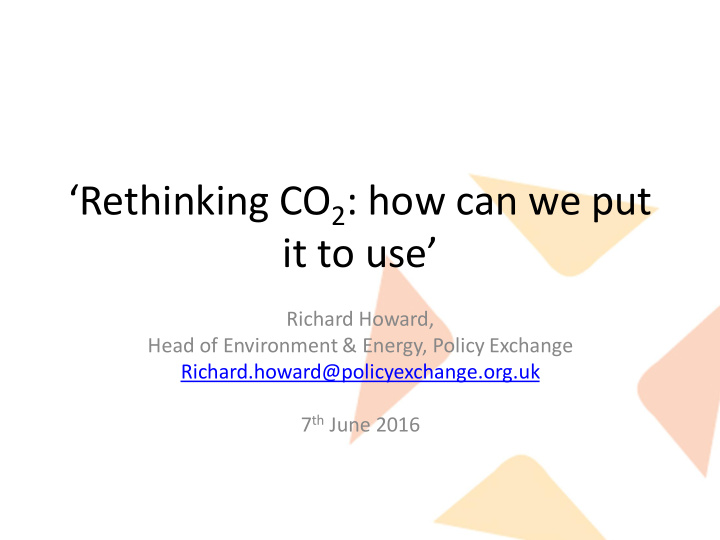



‘Rethinking CO 2 : how can we put it to use’ Richard Howard, Head of Environment & Energy, Policy Exchange Richard.howard@policyexchange.org.uk 7 th June 2016
Importance of Carbon Capture CCC (Fifth Carbon Budget, 2015) : • CCS is very important for reducing emissions across the economy. • The cost of meeting the UK’s 2050 emissions target would double in the absence of CCS deployment. • Industrial CCS development and deployment on a large scale is required to decarbonise industry and meet the 2050 target. IEA (CCS roadmap, 2013): • There is no climate friendly scenario in the long run without CCS.
Carbon Capture and Storage
CCS and CCU
…which have many potential uses
The market for CCU products could be huge… CCU product markets valued at up to $1 trillion p.a. globally by 2030
CCU technologies are close to commercialisation…
Research Activity • Global CO 2 Initiative: Investing up to $1bn over 10 years to commercialise CCU technology • X-Prize: $20m innovation prize for development of commercial CO 2 conversion technologies • EC Horizon 2020: funding for large scale CO 2 re-use • ULCOS: European consortium investigating CCU in context of Ultra-low CO 2 steelmaking • CO 2 Chem: UK / global Carbon Dioxide Utilisation Network (EPSRC funded)
Lack of policy context? • Limited discussion of CCU by DECC / CCC / IPCC • Focus on power sector > industrial decarbonisation • Limited R&D funding for CCU in UK – e.g. £10m CCU out of £125m CCS R&D programme • Lack of financial incentives to pursue CCU • Recognition of CCU in EU ETS / carbon pricing? • Fit with waste / recycling policy?
Questions • What is true potential for CCU? • Which CCU technologies have most promise? • Is CCU commercially viable / at what cost? • Is it a complement / alternative to CCS? • Does it really result in CO 2 reduction? • How should Government(s) support CCU technology development? • Is the UK at risk of being left behind?
Professor Peter Styring UK Centre for Carbon Dioxide Utilisation The University of Sheffield
thermodynamics kinetics
carbonNext
Manufactured Aggregates from CO 2 and Waste Professor CD Hills c.d.hills@gre.ac.uk
Con ontents CO 2 and the geological timescale Natural carbonate structure Mineralisation of CO 2 in waste Manufactured carbonated aggregates from waste Summary
Insert picture of the chalk
After Royer (2006). Geochimica et Cosmochimica Acta 70 (23): 5665 – 75.
Mineralisation of of CO 2 in in waste Steel Wastewater Sludge Quarry Fines Bauxite Paper Ash Metal Dust Wood Ash
Manufactured carbonated agg aggregates Approximately 250 Mtpa*of aggregates used in the UK (25 Gtpa world wide) Approximately 1 Gtpa of x7 CO 2 -reactive wastes are produced world wide Potential to mineralise x Mtpa of CO 2 in waste, whilst making useful products Market forces rule and so disposal will be the only option in some territories C8 has achieved ‘end of waste’ designation for aggregate use in construction blocks The aggregate meets European standards for light- weight aggregate and is ‘fit for purpose’ CO 2 can be used to stabilise/enhance soil geotechnical properties via carbonate ppt. http://www.mineralproducts.org/documents/mpa_facts_at_ a_glance_2014.pdf
Su Summary The mineralisation of CO 2 in products analogous to natural materials is a reality Carbonated aggregates are ‘fit for purpose’ and meet BS EN standards It is likely that ca >0.5 Mtpa aggregates manufactured in the UK by 2019 New applications for carbonation are possible, including to high value materials Key to extending the technology are: - a level regulatory environment - a price for the carbon mineralised, and - lower cost methods to capture CO 2
Resources Carbon8 Video Samples of aggregate Production concrete with carbonated aggregate The world ‘famous’ bottle experiment
Recommend
More recommend